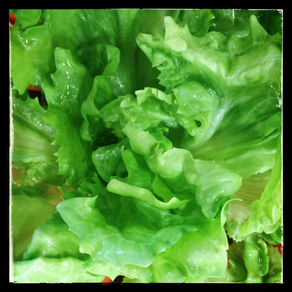Escarole was kind of my gateway for really starting to appreciate chicories. It's the most similar to lettuce, but like all of the chicories, it really is best when the weather gets just a little too cold for lettuce, and it is much more versatile than lettuce. The typical characteristics of chicories is that they have some level of bitterness, but in the right growing conditions (cold weather), that bitterness can be largely overwhelmed by sweet crunchiness. Cooking the chicory (something not done much with lettuce) also moderates bitter flavors.
Bitter flavor isn't something that is common in American cuisine, but it is definitely appreciated in other places and I've really come to love it, in the right setting and matched with the right flavors. The bitterness of the chicories we grow vary with the type and weather, but typically it is subtle and only part of the flavor of the leaves. I find it goes particularly well as a foil to other strong flavors, like the acid of lemon, or strong saltiness, or oiliness, or even sweet. I also like it best in the fall as the weather turns colder; for some reason it's not as appealing to me in the summer time.
The basic fresh salad that I make with most of the chicories is very simple. I shred the leaves and then soak them in cold water (ice water if you have it, I don't usually have ice) for about 5-30 minutes (depending on how patient you are or what else you're doing). Then I spin that dry and dress it generously with olive oil, lemon juice, and coarse salt. Typically the dressing is about 2 or 3 parts oil and 1 part lemon, but you can experiment. I add enough dressing to coat the leaves completely.
I first had this with escarole on a farm just outside of Siena and it was a significant part of the best meal I had while I was in Italy, very simple and very fresh and maybe one of the only salads I had while I was there (vegetables aren't served fresh commonly for some reason). Sometimes I'll add anchovies, or grated pecorino cheese, or a berry jam to the dressing. Sometimes I use vinegar instead of the lemon.
All of the chicories can also be cooked in a variety of ways. One typical preparation for the radicchio and sugarloaf is to cut the heads into wedges, sprinkle them with oil and salt, and then grill, broil or bake them until they are soft. This really brings out the sweet flavor and softens the leaves, which are a bit tougher than lettuce. With catalogna, I frequently add chopped up leaves to stew, especially something like ribollita (which was another part of that great meal I had in Siena).
A variation on the fresh salad approach that I use above is to not soak the leaves or cut them so small (or at all) and to sauté them in hot olive oil and then add the other flavors. Both soaking in cold water and cooking reduce the bitter flavors. Chopping finely and cooking both make the more fibrous leaves easier to chew.
Of the chicories we're growing, escarole and frisee are the two best for straight salads. Radicchio, sugarloaf, and castlefranco are all somewhat similar with tighter heads, and thick, sweet, crunchy ribs. Catalogna is the outlier, looking a bit like dandelion and having the strongest flavor of all. With all of the chicories, I think of the white parts of the ribs as the real treat and the inner, blanched leaves as the best for salads. I often cook the outer leaves and make fresh salad from the inner rosette. On many of them the core is very small, but when there is a significant core, it can be quite sweet, especially when cooked.
On my recent trip to Italy I went on an amazing tour of two chicory farms in Chioggia and learned a lot about how they are grown and used there as well as some of the history of variety selection. I'm hoping to experiment with some of the techniques I learned there and to improve our selection of offerings through the winter.


 RSS Feed
RSS Feed